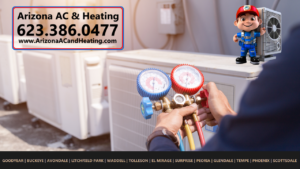Living in a place with distinct seasons like Arizona requires a reliable HVAC system for year-round comfort. But even the most robust furnace, heat pump, or air conditioning unit can’t last forever. So, when the inevitable need for replacement arises, the question becomes: when is the best time to do it?
There isn’t a single, universally perfect answer. However, understanding both practical and financial factors will help you make an informed decision that maximizes comfort, minimizes disruption, and potentially saves you money.
The Downside of Peak Season Furnace, Heat Pump and AC Replacements
 The intense heat of summer and the frigid cold of winter are prime times for HVAC emergencies. This surge in demand puts a strain on service providers, leading to:
The intense heat of summer and the frigid cold of winter are prime times for HVAC emergencies. This surge in demand puts a strain on service providers, leading to:
- Limited Availability: Technicians are booked solid, making it difficult to schedule a convenient installation date. You might be stuck waiting in discomfort as the weather intensifies.
- Higher Prices: Some contractors might adjust their pricing to reflect the higher demand because your options are limited.
- Rushed Installations: With tight schedules, installers might prioritize speed over meticulous attention to detail, potentially leading to future problems.
While a sudden breakdown during peak season might leave you with no choice, proactive planning goes a long way. Here’s why considering a replacement during the shoulder seasons – spring and fall – might be a smarter strategy.
Spring
Spring offers a window of opportunity before the summer heat arrives. Here are some reasons to consider a spring replacement:
- Comfortable Replacement Environment: There is no extreme heat or frigid outdoor temperatures, allowing technicians to work efficiently and thoroughly test the new system.
- Better Availability: Before the summer rush, contractors typically have more flexible schedules, making finding a convenient installation date easier.
- Potential for Deals and Rebates: Many manufacturers offer promotions during the “off-season” to encourage spring purchases. Local utility companies might also offer rebates.
By replacing your furnace or AC in spring, you ensure your home is ready to face the summer heat head-on. You’ll also have time to adjust settings and personalize your comfort level before the hottest days hit.
Tip: Research spring promotions offered by reputable HVAC companies in your area. Consider contacting Arizona AC and Heating for a consultation and a spring replacement quote.
Fall
Similar to spring, fall presents an opportune time for furnace or heat pump replacements before winter’s chill arrives. Here’s why fall might be the ideal time for you:
- Reduced Demand: With the peak cooling season coming to an end, scheduling conflicts become less likely. Technicians are more readily available to accommodate your installation needs.
- Preparation for Winter: Ensure your furnace or heat pump is in top condition before the first frost hits. This prevents potential breakdowns during the coldest months when comfort is paramount.
- Tax Time Considerations: Depending on your financial situation, replacing your HVAC system in the fall might allow you to deduct the expense on your upcoming tax return. (It’s always best to consult with a tax advisor for specific information).
By taking care of the replacement in fall, you can enjoy optimal warmth throughout the winter without worrying about a surprise breakdown.
Signs Your AC or Heating System Needs Replacement
While seasonality plays a role, some telltale signs indicate your furnace, heat pump, or AC might need replacement regardless of the time of year:
- Age: Furnaces generally last between 15 to 20 years, whereas heat pumps and air conditioning units typically have a lifespan of 10 to 15 years. If your system is nearing or exceeding this age, it might be time for an upgrade, even if it’s still functioning.
- Increased Energy Bills: A significant rise in your energy bills might indicate your HVAC system is working less efficiently. Newer models are designed to be more energy-saving, potentially leading to lower utility costs.
- Frequent Repairs: If your system requires frequent repairs, it could be a sign of underlying problems that might not be worth fixing anymore. In the long run, replacing the entire unit could prove to be a more cost-effective solution.
- Reduced Efficiency: Uneven heating or cooling, excessive noise, or difficulty maintaining desired temperatures are all indicators that your system might not be performing optimally.
If you experience any of these signs, consider contacting a qualified HVAC technician for a professional assessment. ArizonaACandHeating.com offers expert advice and can help you determine if a replacement is necessary.
Making the Most of Your Replacement

Once you’ve decided on the best time to replace your furnace, heat pump, or AC, there are additional steps you can take to ensure a smooth and successful process:
- Research Different Models: Consider the energy efficiency ratings (SEER for AC units and HSPF for heat pumps), noise levels, and features like smart home compatibility.
- Get Multiple Quotes: Compare offers from different HVAC companies to ensure you’re getting a fair price and quality service.
- Verify Licensing and Insurance: Make sure the company you choose is licensed and insured to operate in your area.
- Consider Financing Options: Some HVAC companies offer financing plans to help spread out the cost of a new system.
When you follow these steps, you will be able to make informed decisions and ensure that your HVAC replacement process is seamless.
The best time to replace your furnace, heat pump, or AC depends on various factors, including your specific needs, local climate, and personal preferences. Remember, a well-maintained and efficient HVAC system is crucial for year-round comfort in Arizona. By addressing your replacement needs at the right time, you can ensure your home remains a pleasant and healthy environment for years to come.

